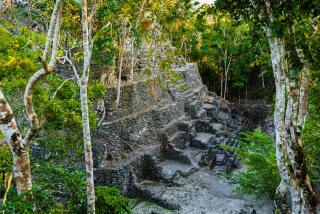Maya ‘doomsday’ may actually be Sunday, archaeologist says
TULUM, Mexico – Hold on to your doomsday fever, folks, the Maya calendar date celebrated Friday as the “end of the world” might actually be off by two days – or a full year.
The end of the 13th baktun cycle of the so-called Long Count of the ancient Maya’s intricate, interlocking calendar system might correspond to Sunday, not Friday, said Carmen Rojas, an archaeologist with Mexico’s National Institute of Anthropology and History.
As “end of the world” hype swept the globe Friday, scholars pointed out that the Maya calendar hasn’t been decoded enough to make exact correlations with the Gregorian calendar that we use.
Rojas stressed that the Maya not only calculated baktun cycles of 144,000 days, but also had systems that measured the marches of Venus and the moon. Other scholars note some Maya glyphs mark dates thousands of years further into the future.
In addition, calendar dates that Maya leaders recorded on pillars that survive to this day might have been modified over time to suit certain cultural or political interests of the day, Rojas said during a walk-through Thursday of the ruins of Tulum, a pre-Hispanic port city situated on a spectacular bluff overlooking coral reefs in the Caribbean Sea.
One such inconsistency leads some Maya scholars to believe the 13th baktun cycle ends on Sunday, while others say it might be off by a full year or more.
Dec. 21 “is not a relevant date for us. It is an accident that someone would take and pull it out,” said Rojas, a specialist in the archaeology of cenotes, a type of sinkhole. “If you look at a book of Maya epigraphy, there are so many dates that could be commemorated. The glyphs are also not so easily interpreted. It depends on the correlation that you use.”
Nonetheless, in recent days, tourists from around the world have flocked to the so-called Maya Riviera on the Caribbean coast of Mexico’s Quintana Roo state, leading to higher-than-normal occupancy at hotels and on flights arriving at Cancun’s international airport, local reports said. Many visitors say they are using the supposed end of the 13th baktun as an opportunity for spiritual reflection and cleansing.
In Guatemala, people are gathering at the Maya site of Tikal for ceremonies marking the end of the baktun cycle and the winter solstice, which does correspond to sunset on Friday. Separately, highland Maya tied to the indigenous rebel army known as EZLN in Mexico’s state of Chiapas have mobilized and occupied at least five towns, reports said.
As tourists arriving on packed buses swarmed the Tulum site on Thursday, one visitor said she came to the region to get married at a nearby resort -- just in case.
“The end of a cycle is the end of a cycle, there are obviously translation issues,” said Rhonda Church, a visitor to Tulum from San Marcos, Texas. “I find it interesting.”
ALSO:
Suspicions swirl over disappearance of activist in Laos
U.N. Security Council approves military mission in Mali
Islamists, opponents clash in Egyptian city of Alexandria
More to Read
Sign up for Essential California
The most important California stories and recommendations in your inbox every morning.
You may occasionally receive promotional content from the Los Angeles Times.









